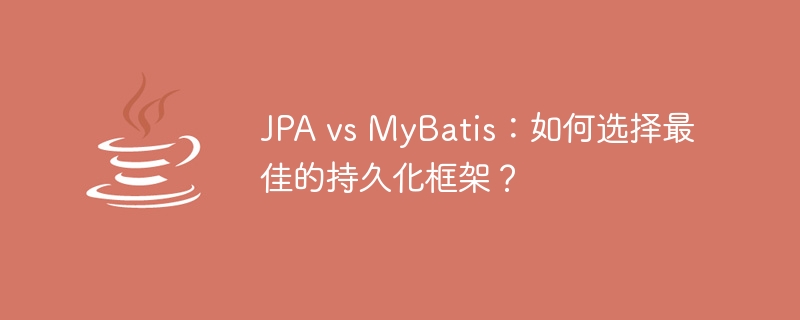Home >Java >javaTutorial >Comparing JPA and MyBatis: How to decide which persistence framework is best?
Comparing JPA and MyBatis: How to decide which persistence framework is best?
- PHPzOriginal
- 2024-02-18 14:12:071397browse

JPA vs MyBatis: How to choose the best persistence framework?
Introduction:
In modern software development, using a persistence framework to handle database operations is essential. JPA (Java Persistence API) and MyBatis are two commonly used persistence frameworks. However, choosing the best persistence framework for your project can be a challenging task. This article will analyze the characteristics of JPA and MyBatis and provide specific code examples to help you make a more informed choice.
Features of JPA:
JPA is a standardized persistence framework defined in Java EE. Its biggest feature is object-oriented model mapping, which maps database tables to Java objects. JPA provides a series of annotations and APIs to realize the mapping between objects and databases. Developers can add, delete, modify, and query the database by operating objects.
The following is an example of using JPA for database operations:
@Entity
@Table(name = "user")
public class User {
@Id
@GeneratedValue(strategy = GenerationType.IDENTITY)
private Long id;
private String name;
//Getters and setters
}
@Repository
public interface UserRepository extends JpaRepository<User, Long> {
}
@Service
public class UserService {
@Autowired
private UserRepository userRepository;
public void saveUser(User user) {
userRepository.save(user);
}
public User getUser(Long id) {
return userRepository.findById(id).orElse(null);
}
public void deleteUser(Long id) {
userRepository.deleteById(id);
}
}In the above example, we use JPA annotations to define the User entity class, and use the JpaRepository interface to provide basic additions, deletions, and modifications Check the operation. In the UserService class, we can directly call the methods in userRepository to perform database operations.
Features of MyBatis:
MyBatis is a Java-based persistence framework that uses XML description files and SQL mapping configuration files to define database operations. MyBatis provides powerful flexibility, allowing developers to directly write SQL statements to operate the database, solving some of the limitations of JPA in complex queries and performance optimization.
The following is an example of using MyBatis for database operations:
public class User {
private Long id;
private String name;
//Getters and setters
}
public interface UserMapper {
@Select("SELECT * FROM user WHERE id = #{id}")
User getUser(Long id);
@Insert("INSERT INTO user (name) VALUES(#{name})")
@Options(useGeneratedKeys = true, keyProperty = "id")
void saveUser(User user);
@Delete("DELETE FROM user WHERE id = #{id}")
void deleteUser(Long id);
}
@Service
public class UserService {
@Autowired
private UserMapper userMapper;
public void saveUser(User user) {
userMapper.saveUser(user);
}
public User getUser(Long id) {
return userMapper.getUser(id);
}
public void deleteUser(Long id) {
userMapper.deleteUser(id);
}
}In the above example, we define database operations by using XML description files and SQL statements in the UserMapper interface. In the UserService class, we can directly call methods in userMapper to perform database operations.
How to choose the best persistence framework?
When choosing the best persistence framework, we need to make trade-offs based on the needs and circumstances of the project.
If your project is a simple CRUD application and you pay more attention to development speed and ease of use, then JPA may be a good choice. JPA provides higher-level abstraction, reduces SQL writing, and improves development efficiency. At the same time, JPA also provides the function of automatically updating the database structure, making database migration more convenient.
If your project is a complex application and requires fine optimization of database performance, then MyBatis may be a better choice. MyBatis allows you to directly write SQL statements to operate the database, providing greater flexibility and room for performance optimization.
Of course, if you are familiar with both frameworks, you can also mix them. For example, you can use JPA in your project for basic CRUD operations, and use MyBatis to handle more complex queries and performance optimization.
Conclusion:
Choosing the best persistence framework requires a comprehensive trade-off based on the needs and circumstances of the project. JPA is suitable for simple CRUD applications, providing higher-level abstraction and rapid development capabilities; MyBatis is suitable for complex applications, allowing direct writing of SQL statements to operate the database, and providing greater flexibility and room for performance optimization. Depending on the specific needs of your project, you may also choose to mix them. No matter which framework you choose, the key is to be familiar with and master its features and usage, and make a reasonable choice based on the actual situation of the project.
The above is the detailed content of Comparing JPA and MyBatis: How to decide which persistence framework is best?. For more information, please follow other related articles on the PHP Chinese website!

